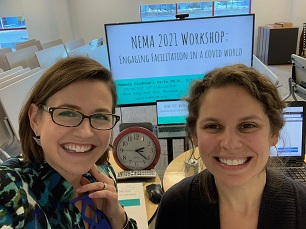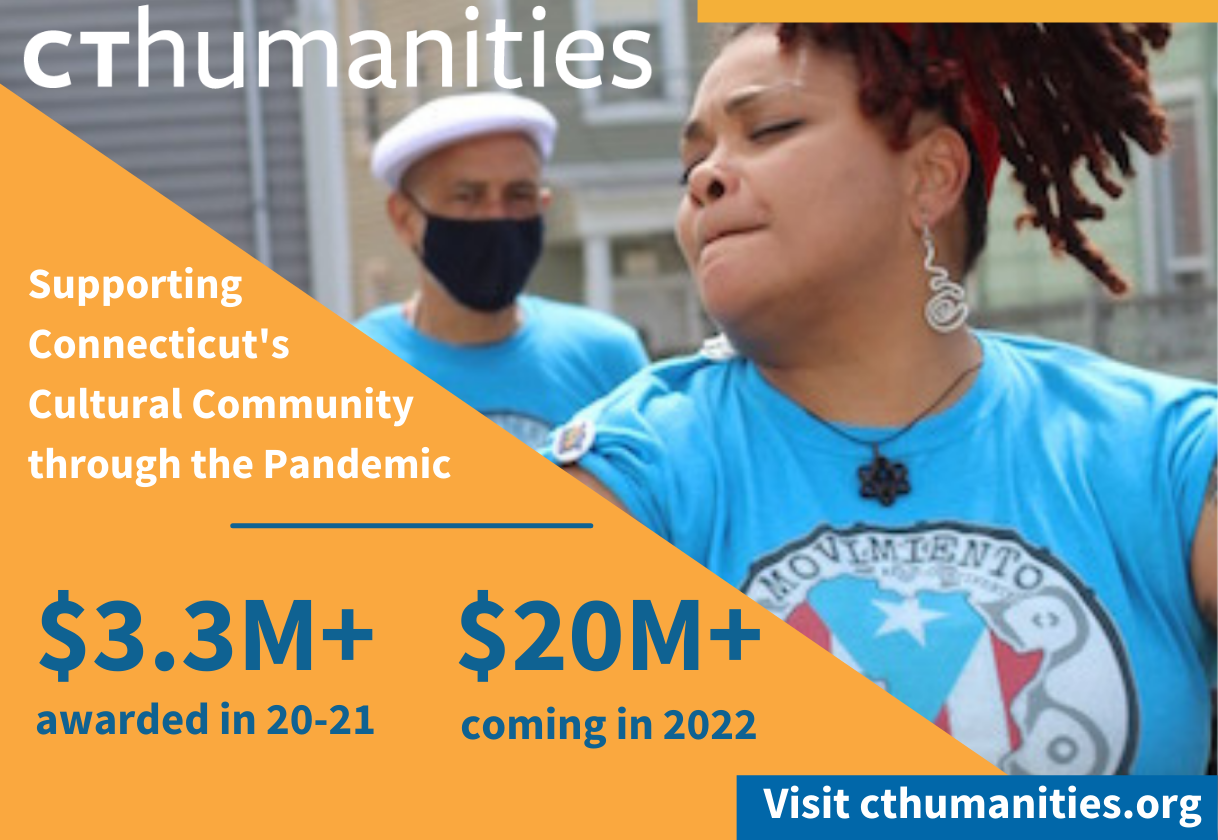
5 Steps to Better Frontline Education Training
By Amanda Goodheart Parks PhD and Erin Wederbrook Yuskaitis
With nearly thirty years of combined experience in frontline interpretation and the training of frontline staff and volunteers, Amanda Goodheart Parks and Erin Wederbrook Yuskaitis served together as NEMA Education PAG Co-Chairs from 2019-2021. This article is drawn from their NEMA 2021 conference session entitled, “Engaging Facilitation in a COVID World.”
1. Training should not just focus on your site’s content.
Erin’s take: I know, we’re starting off with what NOT to do, but this first step is the most important. Institutions often only think of content when planning training for frontline educators, assuming that the most important part of the job is to be a content expert. Unfortunately, that perspective leaves your frontline unprepared for the incredibly complex work of interpretation and public engagement. Serving visitors requires a nuanced understanding of the site itself – including facilities and maintenance – as well as customer service, conflict management, and DEAI (diversity, equity, access, and inclusion). Help your frontline feel prepared for all types of situations, not just delivering information.
Amanda’s take: Our frontline staff are not just content facilitators and ambassadors: they are often asked to be emergency responders and policy enforcers as well. Training should therefore include basic facilities management and emergency protocols, especially if your museum does not have onsite security. My frontline staff complete a scavenger hunt which requires them to track down everything from fire extinguishers to wet floor signs on their first day. It’s also critical to provide training on implicit bias, inclusivity, and accessibility to ensure our sites are safe and welcoming to all visitors. AAM offers toolkits, reading lists, and other resources on incorporating DEAI into your frontline training, and local hotels (especially national brands like Marriott or Hilton) are usually thrilled to partner with nonprofits on customer service training.
2. Incorporate best practices in museum education and interpretation.
Erin’s take: Keep in mind that the vast majority of museum volunteers, docents, educators, etc. do not have degrees in museum studies or museum education. They often come to the site out of passion and interest. Excellent. It is then the site’s job to help them feel prepared to practice museum education and become trained in what it means to be a museum education professional. The cerebral side of this work is important. They need to understand the WHY, which will help inform the HOW. Why are tours created as they are? What’s the importance of learning outcomes? Why does the site take this approach? How can I teach different age groups? What are the contexts of the visitor experience? How can I master interpretation? I personally rely heavily on John Falk and Lynn Dierking, George Hein, Nina Simon, and the foundational work of Freeman Tilden. Many other scholarly perspectives can help you frame your own approach to training. Treat your frontline as the adult learners they are.
Amanda’s take: Consider adding learning and interpretation theory to your frontline staff training. Nina Simon’s participatory design, Howard Gardner’s theory of multiple intelligences, and Freeman Tilden’s six principles of interpretation are not just the stuff of teacher prep programs or graduate courses, after all! Your local school district’s curriculum office is a great resource for K-12 learning theory materials, and universities that offer public history or museum studies programs often have reading lists available to the public.
3. Incorporate whole body facilitation into your training.
Erin’s take: Our frontline staff are using their voices and bodies all day to convey ideas and emotions, to teach complex concepts, and to engage visitors in an entertaining way. Techniques used in acting are extremely helpful for people talking, projecting, gesturing, interacting, moving through tricky spaces – in other words, frontline staff. Training in whole body facilitation is best done in-person, particularly in the specific spaces where the frontline will work. Furthermore, PRACTICE with these techniques is crucial. Practicing as a group helps everyone feel less silly and more supported. Vocal exercises in annunciation, projection with or without a microphone, and tongue twisters provide fun ways to break the ice as well during training!
Amanda’s take: As masks come off and social distancing requirements fade, consider keeping whole body facilitation as part of your frontline training. Vocal supports like diaphragmatic breathing and projection, as well as body language exercises help ensure we are welcoming visitors not just with our voices (and smiles!), but with our bodies. Improv troops, community theaters, and high school theater departments are all great resources for games, activities, and exercises that can support whole body frontline facilitation.
4. Invest in training as a budgeted, ongoing process.
Erin’s take: The training of your frontline should be a line item in the education department’s budget every year. This profession requires ongoing learning and development (for you and your frontline!). We often expect the frontline to move mountains when it comes to providing exceptional customer service and public engagement. How often do we invest as much money and time as we should in their preparation and fulfillment of such expectations? We owe them respect and continuous support, which they deserve and need in order to thrive in their roles. A consistently updated training manual is an incredible resource to provide to all frontline before or during training, as well as consistent opportunities to gather, troubleshoot, connect, and grow.
Amanda’s take: I echo the need for a training manual– it’s a must! This should be a living document that is reviewed annually to ensure training materials are up to date with institutional goals as well as new ideas from the field. Offering regular, ongoing training throughout the year creates opportunities to spotlight new exhibits, techniques, and programs, as well as build camaraderie. It also allows you to stay engaged with your frontline. Consider offering coffee/tea, a snack, or lunch at these training sessions. As a former frontline educator, I can attest that a little sustenance goes a long way in building community as well as achieving learning goals.
5. Consider bringing in an outside expert/consultant.
Erin’s take: As someone who previously provided the in-house training for my site’s frontline for seven years, I can tell you that sometimes the voice most respected is the one from someone outside. Even with incredible internal rapport, constantly listening to your direct supervisor on all the topics is like listening to your parents: it gets old. An outside consultant provides a fresh perspective and lends much-needed expertise, particularly on specific topics like inquiry-based facilitation, DEAI in practice, and dealing with difficult visitors. Moreover, training feels more like professional development to the frontline when they hear from other voices. Make the investment. Be thoughtful and intentional. Nothing affects your visitors’ experiences more than the quality of your frontline’s training.
Amanda’s take: Remember that you don’t have to go it alone. Our region is filled with amazing museum people doing amazing museum work. If your budget does not support bringing in a paid consultant, partner with another organization to split the cost, or invite a colleague to your site for the day on a staff exchange. If your budget supports offsite training, bring your frontline staff to another museum to meet their peers, observe programs, or discuss a particular topic. Field trips are fun for everyone! NEMA PAG Chairs are a great resource for making connections between different organizations, and participating in programs like NEMA’s webinars, workshops, and the annual conference will help expand your network of colleagues (and future trainers!).
Good luck and have fun!

—
Erin Wederbrook Yuskaitis is the Principal for Yellow Room Consulting LLC. She specializes in visitor learning, innovative program development, and cross-discipline meaning-making as well as the broad applications of Visual Thinking Strategies and museum education principles to industries and sectors outside the museum world.
Amanda Goodheart Parks Ph.D. is a public historian and museum educator specializing in creating meaningful opportunities for people to engage with the past. She serves as Director of Education at the New England Air Museum where her work was awarded an AAM EdComm Award for Innovation and Education. She is a proud member of the NEMA Board of Directors.
